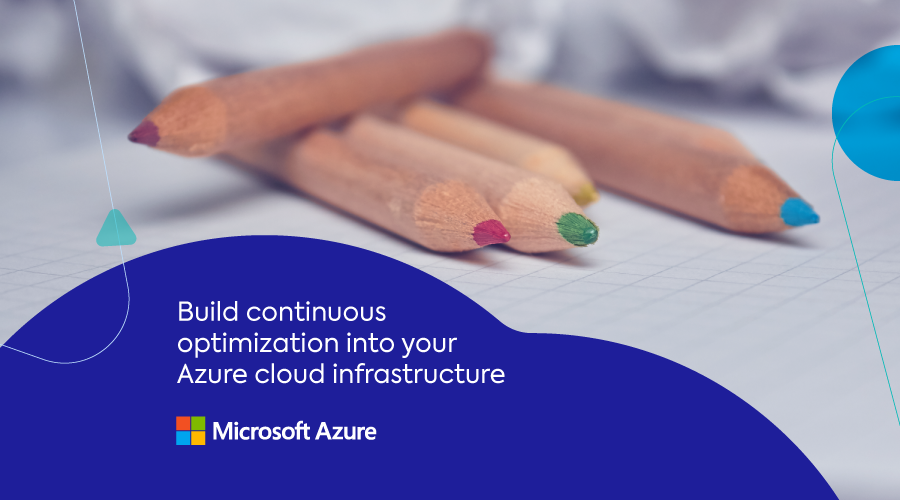
The five critical elements to achieving continuous optimization of your Azure infrastructure
Developing a successful Azure cloud operations (CloudOps) practice is the key to unlocking the full benefits of Microsoft’s Azure cloud platform. But Azure users often struggle to take full advantage of Azure’s benefits once they’ve made the move to the cloud. While it might be easy to build infrastructure inside of Azure and start spending money, ensuring your cloud infrastructure continues to support your organization’s business objectives as you scale is hard work.
Once your workloads are successfully operating in Azure, the following concerns are likely to arise:
- How do we efficiently and cost-effectively scale that infrastructure in a way that minimizes risk while ensuring performance and uptime?
- How do we control costs and charge back cloud usage to appropriate departments to meet the business’s objectives?
- How do you use your existing cloud infrastructure estate to guide data-driven decision making regarding future growth at scale, while still architecting within the guidelines of the Microsoft Azure Well-Architected Framework?
The hard truth
As usage and workloads grow, cloud operations teams experience increased pressure on multiple fronts. They are asked to operate faster and accelerate deployments to satisfy their product teams and increase the scalability and flexibility of their workloads to bring applications and services to market faster, all the while being asked by finance and executive teams to control costs. Moreover, when we factor in the demands and priorities of non-technical stakeholders such as finance, sustainability officers, compliance teams, internal and external auditors, and management, it can become too much for your operations teams to handle without adopting additional tools.
While the Microsoft Azure portal offers many valuable services to help you overcome these common hurdles, it may not provide a comprehensive enough optimization solution to support the business’s needs over the long term. It can also be complex and time-consuming, forcing the user to toggle through multiple blades and views to uncover key insights about workloads, understand how services are linked and provision and deploy the right infrastructure.
A typical day in the life of “Dan the Cloud Architect” at WidgetCo Labs
Let’s consider this from the perspective of Dan, a cloud architect for a mid-sized enterprise, and his team of two junior engineers. Together, they bear the responsibility of designing, maintaining, and monitoring the performance of their cloud infrastructure, which includes storage, VMs, and AKS clusters, and ensuring deployments of their company’s flagship application.
Unfortunately, Dan and his team lack the necessary automation and optimization processes to efficiently operate their Azure infrastructure at scale. As a result, they often find themselves working late nights, sacrificing weekends, and even canceling vacations to manually troubleshoot performance issues and fix outages and failed deployments.
Beyond these frustrations, the truth is that Dan and his team find infrastructure management and optimization tasks to be an inefficient use of their time. The constant complaints and emergency calls they receive when resources go down add to their stress and, unfortunately, reflect poorly on their abilities.
What are the “Big 5” of Azure infrastructure optimization, and how can they help Dan and his team?
- Actionable visibility – Visualizing cloud resource utilization, alerts, and forecasting enables business stakeholders to make informed business decisions.
- Peak performance – Assigning resources with the appropriate compute resources is a necessary step to satisfy workload and traffic requirements.
- Total efficiency – Avoiding wasteful provisioning and idle resources means using techniques such as autoscaling, bin packing and rightsizing, and considering operational, budget and application efficiency.
- Cost optimization – Running truly cost optimized Azure infrastructure includes optimizing utilized resources for cost to keep expenses to a predictable minimum by leveraging and managing reserved commitments, taking advantage of excess capacity compute (a.k.a. spot VMs), and scheduling shutdown hours according to availability requirements.
- Intelligent automation – Replacing the most burdensome manual processes, such as infrastructure provisioning and management, with intelligent automation provides predictive infrastructure and application-driven scaling as well as AI-driven selection and predictive rebalancing of all cloud pricing models for the optimal blend of resource types at the best price.
Building the “Big 5” into your Azure Cloud Operations with Spot
In our interactive eBook, The “Big 5” of continuous optimization of Azure cloud infrastructure, we explore the top challenges cloud operations teams encounter with running continuously optimized Azure cloud infrastructure. We also uncover the key stumbling blocks and present the five essential components of continuous Azure infrastructure optimization and offer practical guidance on how to effectively implement the Big 5. This ensures your Azure workloads are continuously running on the most operationally efficient and cost-effective infrastructure.
With the “Big 5” in place, you can confidently drive operational excellence and maximize the value of your Azure environment. To learn more visit spot.io/azure-big-5.
Ready to start optimizing now? Check out these additional resources:

